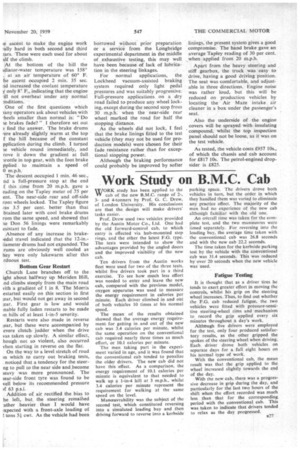Work Study on B.M.C. Cab
Page 61

If you've noticed an error in this article please click here to report it so we can fix it.
WORK study has been applied to the cab of the new B.M.C. range of 2-, 3and 4-tonners by Prof. G. C Drew, of London University. His conclusions are that the design will make drivers' tasks easier_
Prof. Drew used two vehicles provided by the Austin Motor Co., Ltd. One had the old forward-control cab, to which entry is effected via hub-mounted step rings, and the other the latest F.G. type. The tests were intended to show the advantages provided by the angled doors and the improved visibility of the new cab.
Ten drivers from the Austin works fleet were used for two of the three tests, whilst five drivers took part in a third exercise. To see how much less effort was needed to enter and leave the new .cab, compared with the previous model, oxygen apparatus was used to measure the energy requirement in calories per minute. Each driver climbed in and out of both vehicles 10 times at his normal speed.
The mean of the results obtained showed that the average energy requirement for getting in and out of the nevi cab was 3.4 calories per minute, whilst the same operation on the conventional cab required nearly three times as much effort, or 10.1 calories per minute_ The men taking part in the experiment varied in age, and it was found that the conventional cab tended to penalize the older drivers. The new cab did not have this effect. As a comparison, the energy requirement of 10.1 calories per minute is equivalent to that needed to walk up a 1-in-4 hill at 3 m.p.h., whilst 3.4 calories per minute represent the requirement for walking at the same speed on the level.
Manceuvrability was the subject of the second test, which constituted reversing into a simulated loading bay and then driving forward to reverse into a kerbside parking space. The drivers drove both vehicles in turn, but the order in which they handled them was varied to eliminate any practice effect. The majority of the men had no experience of the new cab although familiar with the old one.
An overall time was taken for the complete test, and the two manceuvres were timed separately. For reversing into the loading bay, the average time taken with the conventional cab was 26.8 seconds and with the new cab 22.2 seconds.
The time taken for the kerbside parking test by the vehicle with the conventional cab was 31.4 seconds. This was reduced by over 20 seconds when the new vehicle was used.
Fatigue Testing
It is thought that as a driver tires he tends to exert greater effort in moving the controls, whilst his grip on the steering wheel increases. Thus, to find out whether the F.G. cab reduced fatigue, the two vehicles were fitted with pressure-sensitive steefing-wheel rims and mechanism to record the grip applied every six minutes throughout a day's work.
Althtugh five drivers were employed for the test, only four produced satisfactory results, as the other gripped the spokes of the steering wheel when driving. Each driver drove both vehicles on separate days for a full eight hours on his normal type of work.
With the conventional cab, the mean result was that the grip applied to the wheel increased slightly towards the end of the day.
With the new cab, there was a progressive decrease in grip during the day, and particularly for the last two hours of the shift when the effort recorded was much less than that for the corresponding period with the conventional cab. This was taken to indicate that drivers tended to relax as the day progressed.




































































































